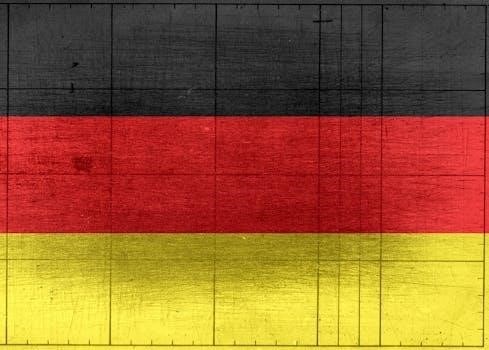Linkage disequilibrium (LD) at the CD4 locus offers insights into human origins. Studies analyze the non-random association of alleles in geographically diverse populations. This unveils patterns reflecting population history‚ migrations‚ and the recency of emigration from Africa.

CD4 Locus⁚ Location and Polymorphisms
The CD4 locus‚ found on chromosome 12‚ contains vital genetic markers. These markers include STRPs and Alu deletion polymorphisms. Analyzing these variations helps trace evolutionary events and population relationships‚ contributing to the study of human origins.
Location of CD4 Gene on Chromosome 12
The CD4 gene‚ a crucial element in immune response‚ resides on the short arm of chromosome 12. Specifically‚ the studied polymorphic markers are located within non-coding regions of the CD4 gene. Its precise chromosomal location facilitates genetic studies aimed at understanding human evolution and disease susceptibility. Mapping the CD4 locus allows researchers to analyze its genetic diversity across different populations. This analysis often includes examining short tandem repeat polymorphisms (STRPs) and Alu insertion/deletion polymorphisms. These polymorphic markers evolve at different rates‚ providing valuable insights into population history and migration patterns. The location of CD4 on chromosome 12 is pivotal for understanding its role in linkage disequilibrium studies.
Polymorphic Markers within the CD4 Gene
The CD4 gene harbors several polymorphic markers‚ crucial for studying genetic variation and linkage disequilibrium (LD). Among these‚ short tandem repeat polymorphisms (STRPs) and Alu deletion polymorphisms are particularly informative. STRPs‚ characterized by repetitive DNA sequences‚ exhibit high mutation rates‚ making them useful for tracing recent evolutionary events. Alu deletion polymorphisms‚ involving the presence or absence of Alu elements‚ offer complementary insights due to their different mutation mechanisms. Analyzing these markers within the CD4 gene provides a powerful approach to investigate population structure and history. The combination of STRPs and Alu polymorphisms allows researchers to assess both recent and older demographic events. Examining their patterns of LD reveals vital information about human origins and migrations. The nonrandom association between alleles is key.

Linkage Disequilibrium (LD)⁚ Definition and Significance
Linkage disequilibrium (LD) refers to the non-random association of alleles at different loci within a population. In essence‚ it describes a situation where certain combinations of alleles occur together more or less frequently than expected under random assortment. LD arises due to various factors‚ including physical proximity of genes on a chromosome‚ reduced recombination rates‚ and recent population admixture. The significance of LD lies in its ability to provide insights into population history‚ genetic mapping‚ and evolutionary processes. High LD suggests limited recombination and potentially recent common ancestry. Conversely‚ low LD indicates extensive recombination and older‚ more diverse populations. Understanding LD patterns is crucial for identifying disease-associated genes and tracing human migrations. LD mapping leverages the correlation between genetic markers and disease loci.
Study Methodology⁚ Population Sampling and Analysis
The study involved sampling geographically dispersed populations and analyzing STRP and Alu deletion polymorphisms. This approach is for understanding global patterns of linkage disequilibrium at the CD4 locus and its implications for modern human origins.
Sampling of Geographically Diverse Populations
To understand the global patterns of linkage disequilibrium (LD) at the CD4 locus‚ a comprehensive sampling strategy was employed. This encompassed a wide array of geographically dispersed populations‚ ensuring representation from different continents and regions. The selection included 13 African‚ 2 Middle Eastern‚ 7 European‚ 9 Asian‚ 3 Pacific‚ and 8 Amerindian populations‚ thus accounting for the major human population groups across the globe.
This diverse sampling is important to capture genetic variation and patterns of LD that have arisen due to historical migrations‚ population bottlenecks‚ and genetic drift. Such a broad geographic scope allowed researchers to assess how LD varies across populations‚ providing insights into human evolutionary history and the recency of shared ancestry. The intent was to create a robust dataset for analyzing haplotype variation and LD patterns at the CD4 locus.
Analysis of STRP and Alu Deletion Polymorphisms
The study of linkage disequilibrium (LD) at the CD4 locus involved detailed analysis of two types of polymorphic markers⁚ short tandem repeat polymorphisms (STRPs) and Alu deletion polymorphisms. These markers‚ located approximately 9.8 kb apart within non-coding regions of the CD4 gene on chromosome 12‚ were selected due to their differing mutation rates and modes of evolution.
STRPs are highly mutable and provide insights into recent population history‚ while Alu elements offer a more stable marker for older evolutionary events. Analyzing haplotypes consisting of alleles at both the STRP and Alu deletion polymorphisms allowed researchers to assess the non-random association between these markers. The presence and extent of LD between these polymorphisms were then assessed across the sampled populations‚ revealing valuable information about shared ancestry and migration patterns.

Global Patterns of LD at the CD4 Locus
Analysis of the CD4 locus across diverse populations revealed distinct global patterns of linkage disequilibrium (LD). A key finding was the strong LD observed between the STRP and Alu deletion polymorphisms‚ particularly in non-African populations. This non-random association indicates a shared history and limited recombination events since the origin of these haplotypes.
African populations‚ conversely‚ exhibited lower levels of LD and greater haplotype diversity. This suggests a longer period of evolution and more opportunities for recombination to break down ancestral associations. The observed LD patterns support the “Out of Africa” theory‚ suggesting a recent expansion from Africa with a subset of ancestral haplotypes carried to other regions. The strength of LD decreased with geographic distance from Africa‚ further supporting this model.
Implications for Modern Human Origins
CD4 locus LD patterns support a recent “Out of Africa” origin. Non-African populations show stronger linkage disequilibrium. This indicates less time for recombination since their divergence from African ancestors‚ reinforcing the recency of emigration.
Support for the “Out of Africa” Theory
Analysis of linkage disequilibrium (LD) at the CD4 locus provides genetic evidence supporting the “Out of Africa” theory of modern human origins. The theory posits that modern humans originated in Africa and subsequently migrated to populate other parts of the world. The global pattern of haplotype variation observed at the CD4 locus aligns with this model. Studies analyzing short tandem repeat polymorphism (STRP) and Alu deletion polymorphisms in diverse populations reveal that African populations exhibit lower levels of LD compared to non-African populations. This suggests that African populations have had a longer time for recombination events to break down ancestral haplotypes‚ reflecting their greater genetic diversity and longer evolutionary history.
Recency of Emigration from Africa
The extent of linkage disequilibrium (LD) at the CD4 locus provides insights into the recency of human emigration from Africa. Higher levels of LD are observed in non-African populations. This indicates that these populations experienced founder effects and genetic bottlenecks during their migration out of Africa. These events reduced genetic diversity and increased LD due to limited time for recombination to break down ancestral haplotype structures. The observed LD patterns suggest a relatively recent emigration from Africa‚ as the non-African populations have not had sufficient time to accumulate the same level of genetic diversity and break down LD to the extent seen in African populations.

Linkage Disequilibrium and Disease Gene Mapping
Linkage disequilibrium (LD) plays a crucial role in mapping disease genes. LD refers to the non-random association of alleles at different loci. This can be used to identify genomic regions associated with specific diseases. By analyzing LD patterns across the genome‚ researchers can pinpoint markers that are closely linked to disease-causing genes. When a marker allele is found to be in strong LD with a disease phenotype‚ it suggests that the disease gene is located nearby. Fine-mapping efforts can then focus on this region to identify the causal variant. LD-based mapping is particularly useful for complex diseases where multiple genes and environmental factors contribute to the phenotype.
Factors Influencing LD Patterns
Recombination rate significantly influences linkage disequilibrium (LD) patterns. Faster recombination reduces LD‚ while slower rates maintain it. Population history‚ including bottlenecks and migrations‚ also shapes LD by altering allele frequencies and introducing new variations.
Recombination Rate
Recombination plays a crucial role in shaping linkage disequilibrium (LD) patterns at the CD4 locus. It is the process by which genetic material is exchanged between chromosomes during meiosis‚ leading to new combinations of alleles. A high recombination rate promotes the breakdown of LD by shuffling alleles at linked loci‚ reducing non-random associations. Conversely‚ low recombination rates preserve LD‚ maintaining the association between alleles over longer stretches of DNA. Regions with high recombination rates exhibit lower LD‚ while regions with suppressed recombination show higher LD. Therefore‚ variations in recombination rates across the genome contribute significantly to the observed global patterns of LD at the CD4 locus and other genomic regions. The ability to predict levels of LD between linked markers hinges on understanding recombination.
Population History
Population history significantly influences linkage disequilibrium (LD) patterns observed at the CD4 locus. Events such as population bottlenecks‚ founder effects‚ and migrations can dramatically alter LD patterns. Bottlenecks‚ where a population experiences a drastic reduction in size‚ can increase LD by randomly eliminating rare alleles and increasing the frequency of others. Founder effects‚ occurring when a small group establishes a new population‚ can also lead to elevated LD due to the limited genetic diversity of the founders. Population admixture‚ or the mixing of previously isolated populations‚ can initially increase LD by creating novel allele combinations‚ followed by a gradual decay as recombination breaks down these associations. Therefore‚ understanding the demographic history of different populations is essential for interpreting the global patterns of LD observed at the CD4 locus.
In conclusion‚ studies of linkage disequilibrium (LD) at the CD4 locus provide valuable insights into human evolution and population history. The observed global patterns of LD support the “Out of Africa” theory‚ suggesting a recent common origin for all non-African populations. Furthermore‚ the analysis of LD at this locus contributes to our understanding of the timing and routes of human migrations across the globe. The data obtained from these studies serve as a crucial resource for evolutionary inference and can be utilized in mapping strategies for identifying disease genes. By examining the interplay between genetic variation and population dynamics‚ CD4 locus LD studies continue to enhance our knowledge of human origins and genetic diversity. These findings underscore the importance of LD analysis in unraveling the complexities of human history and disease susceptibility.
